Weather at Machu Picchu
To talk about Weather at Machu Picchu, we must know that Machu Picchu is located in the high jungle of the Amazon, in Peru, Cusco. The climate is hot and humid during the day and cool at night. The temperature ranges from 12ºC to 24ºC. Generally rainy (1955 mm per year) especially between November and March.
The most frequently asked questions about traveling to Machu Picchu are about the weather. We have compiled the best information, along with some other data to help you decide when to travel and how to prepare for your trip.
The climate of Machu Picchu can be a dilemma for any traveler who does not invest the time and research necessary to fully understand its peculiar subtropical nature.
Machu Picchu’s location in the mountains makes it prone to cold winds and the surrounding rainforest adds another unpredictable element. In general, Machu Picchu’s climate can be divided into two seasons; wet and dry. Even within these two seasons, it is not uncommon for drastic and rapid changes to occur on the same day.
Rainy Season in Machu Picchu
In the summer months on this side of the globe, from November to March, it basically rains every day.
If possible, avoid visiting Machu Picchu between these months, unless you like fog and rain.
During these months, rains occur every day, representing about 80% of the annual rainfall in this period.
The level of rainfall is reduced by half between March and April, before stopping when the dry season arrives. During this period of heavy rains, the humidity level reaches 91%, which is absolutely huge!
There will be days when you won’t see Machu Picchu until the afternoon due to the large amount of fog that rises from the jungle and covers the citadel.
Dry season in Machu Picchu
This is the best time of year to visit Machu Picchu, but as these months are the best, there are many people to visit and Machu Picchu and Cusco will be full of people.
September is still a dry month, although not to the same extent as the other dry months.
October has the same level of rainfall as April and can be considered the month of transition to the rainy season.
When it rains, it never lasts more than an hour or two at most and then it will stop.
Humidity levels between these months are lower than in the dry months, making a trip to Machu Picchu in the morning with high visibility an easier feat.
During the dry months the hours of sunshine are twice as much as during the rainy season, making an early start to see the sunrise over Machu Picchu a better prospect. The average temperature during the dry season ranges between 17 and 19 degrees.
At night, the temperature drops a lot, sometimes even below freezing point, due to the clear skies that let heat escape.
Best Time to Visit Machu Picchu
The best time to visit Machu Picchu is the dry season, as there is no rain and Machu Picchu will be clear for you to see in all its splendor.
We have a complete guide about best time to visit Machu Picchu.
Pros of Weather at Machu Picchu
Machu Picchu is located in the Andes Mountains in Peru and is known for its breathtaking views and historical significance. Here are some of the pros of the weather at Machu Picchu:
- Mild temperatures: The temperature at Machu Picchu is generally mild, ranging from the mid-50s to mid-70s Fahrenheit (12-24 Celsius) during the day. This makes it a comfortable climate for exploring the ancient ruins and hiking the surrounding mountains.
- Low precipitation: While the region does receive some rainfall, the dry season (May-September) has very little precipitation, making it an ideal time to visit if you want to avoid rain and muddy hiking trails.
- Stunning views: The weather at Machu Picchu can provide stunning views of the surrounding mountains, valleys, and cloud forests. Clear skies during the dry season provide excellent visibility and photo opportunities.
- Fewer crowds: The weather during the shoulder season (April and October-November) can be unpredictable, but it also means there are fewer tourists. This can make for a quieter and more peaceful visit.
- Unique experiences: The weather at Machu Picchu can offer unique experiences, such as the chance to witness the sunrise or sunset over the ruins, or to see the mountains and valleys shrouded in mist and clouds.
- Pleasant evenings: The temperature at night tends to drop, but remains comfortable enough for evening strolls and stargazing. The clear skies also make it an ideal time for astronomy enthusiasts to observe the stars and constellations.
Cons of the Weather at Machu Picchu
While the weather at Machu Picchu has many pros, there are also some cons to consider:
- High altitude: Machu Picchu is located at a high altitude of over 7,900 feet (2,400 meters) above sea level. This can lead to altitude sickness for some visitors, which can be exacerbated by the dry air and physical exertion of hiking.
- Unpredictable weather: The weather at Machu Picchu can be unpredictable, especially during the shoulder season (April and October-November) when there is more rain and cloud cover. This can affect visibility and make hiking more challenging.
- Crowds during peak season: During the peak season (June-August), Machu Picchu can become crowded with tourists. This can make it harder to fully enjoy the experience, especially if you prefer a quieter, more peaceful environment.
- Limited availability of permits: To protect the site and limit the number of visitors, only a certain number of permits are issued each day for hiking the Inca Trail and entering Machu Picchu. These permits can sell out quickly, especially during peak season.
- Challenging terrain: While the weather may be mild, the terrain around Machu Picchu can be challenging. The steep inclines, rocky paths, and narrow staircases can make hiking difficult and require a good level of physical fitness.
- Limited services: Due to the remote location of Machu Picchu, there are limited services available, such as food and lodging. This can make it more challenging to plan your trip and ensure you have everything you need.
Average Weather in Machu Picchu
Average temperature
The months with the highest average low temperature are January, February, March, November and December (55°F). The coldest months (with the lowest average low temperature) are June and July (48°F).
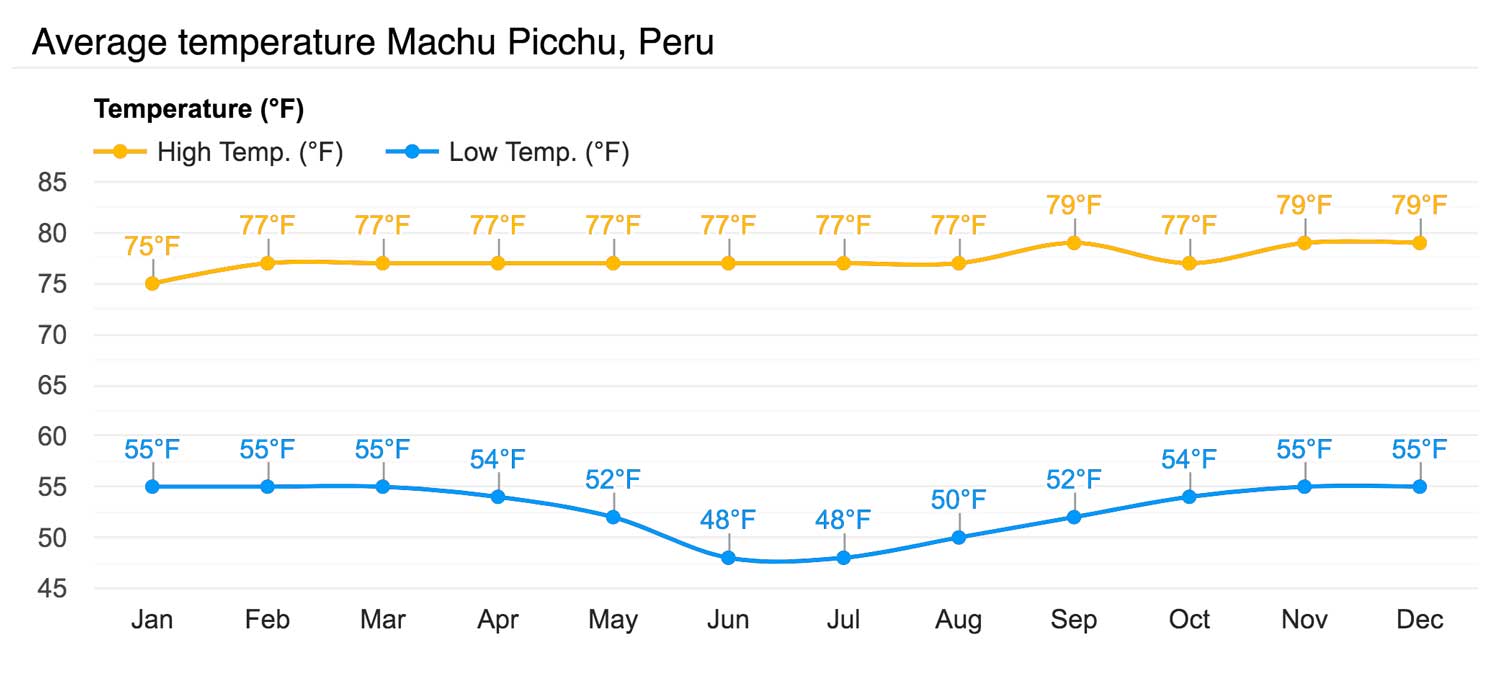
Average rainfall
The wettest month (with the highest rainfall) is March (5.9″). The driest month (with the least precipitation) is June (0.7″).
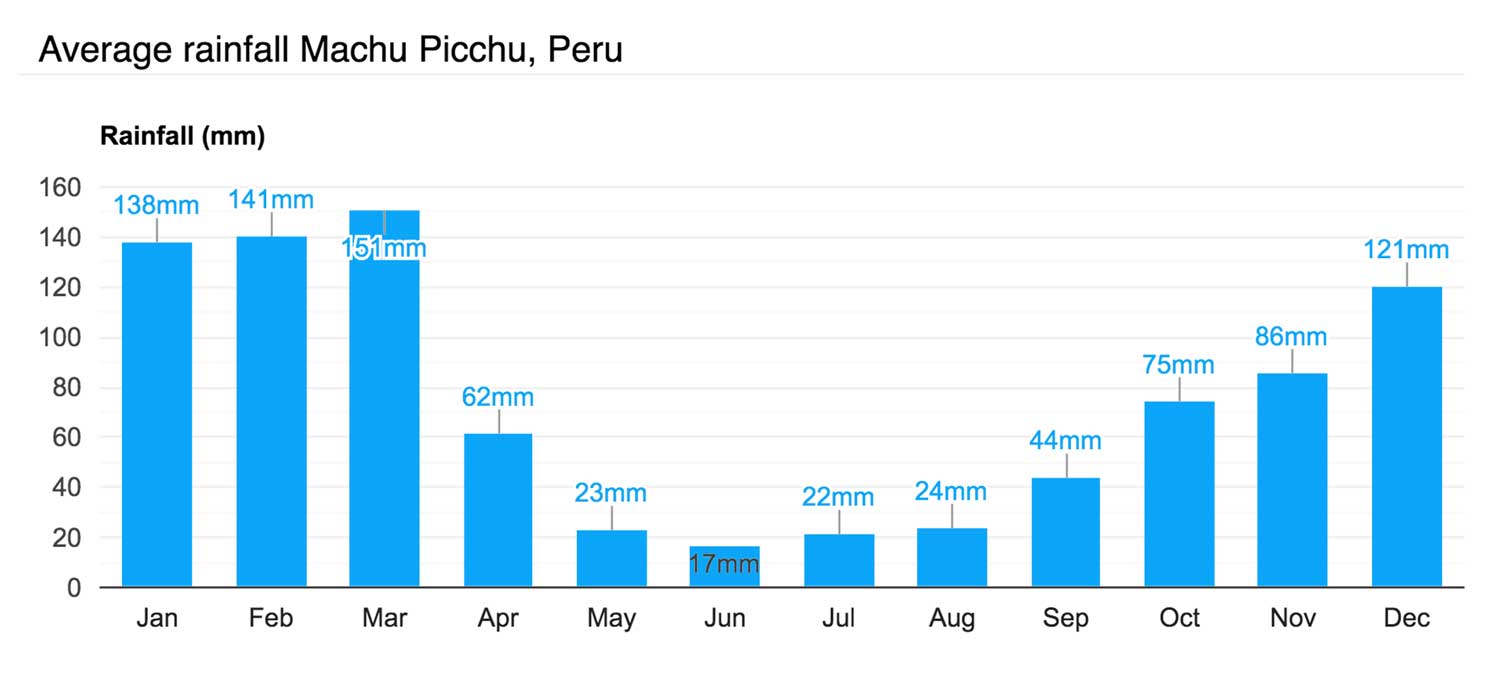
Average rainfall days
The month with the highest number of rainy days is February (20 days). The months with the fewest rainy days are June and July (2 days).
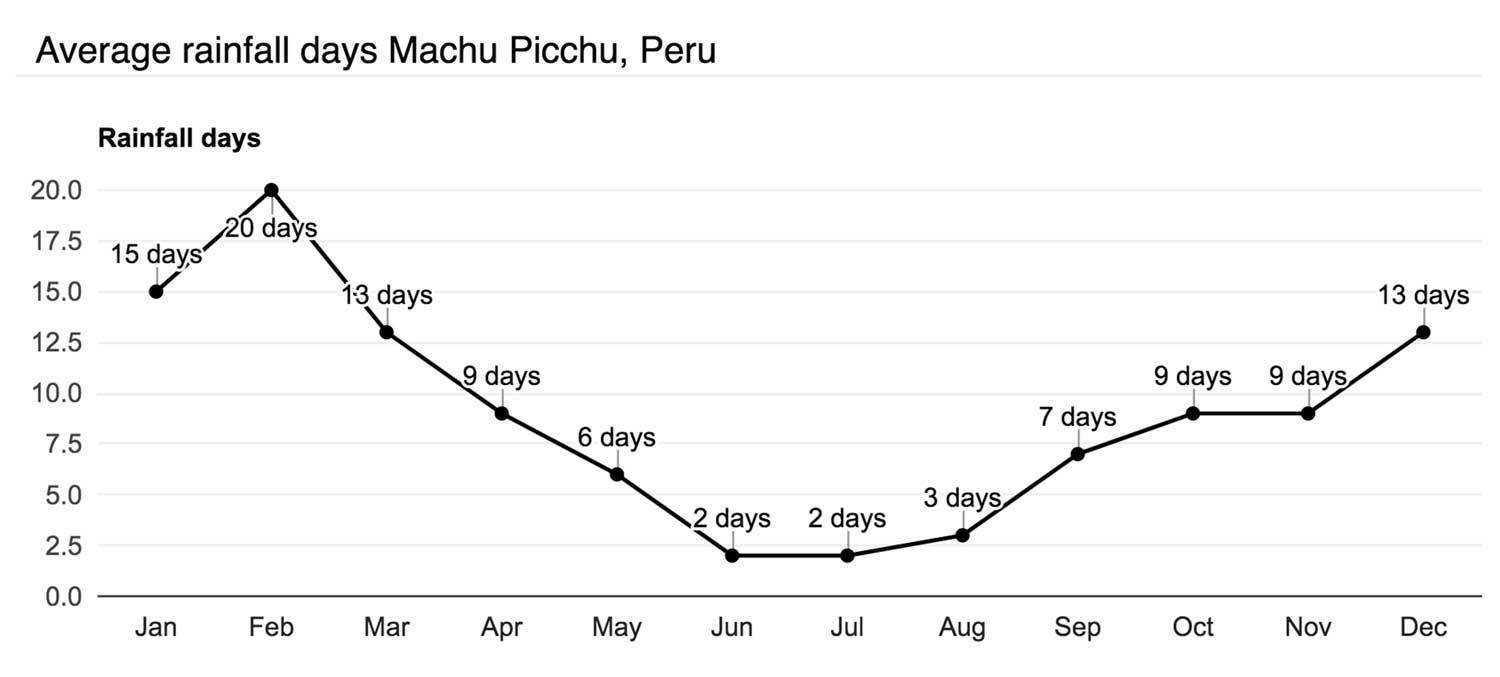
Average daylight / Average sunshine
The sunniest months are May, June, July and August (Sun average: 8h). The months with the least sun are January and February (Sun average: 5h).
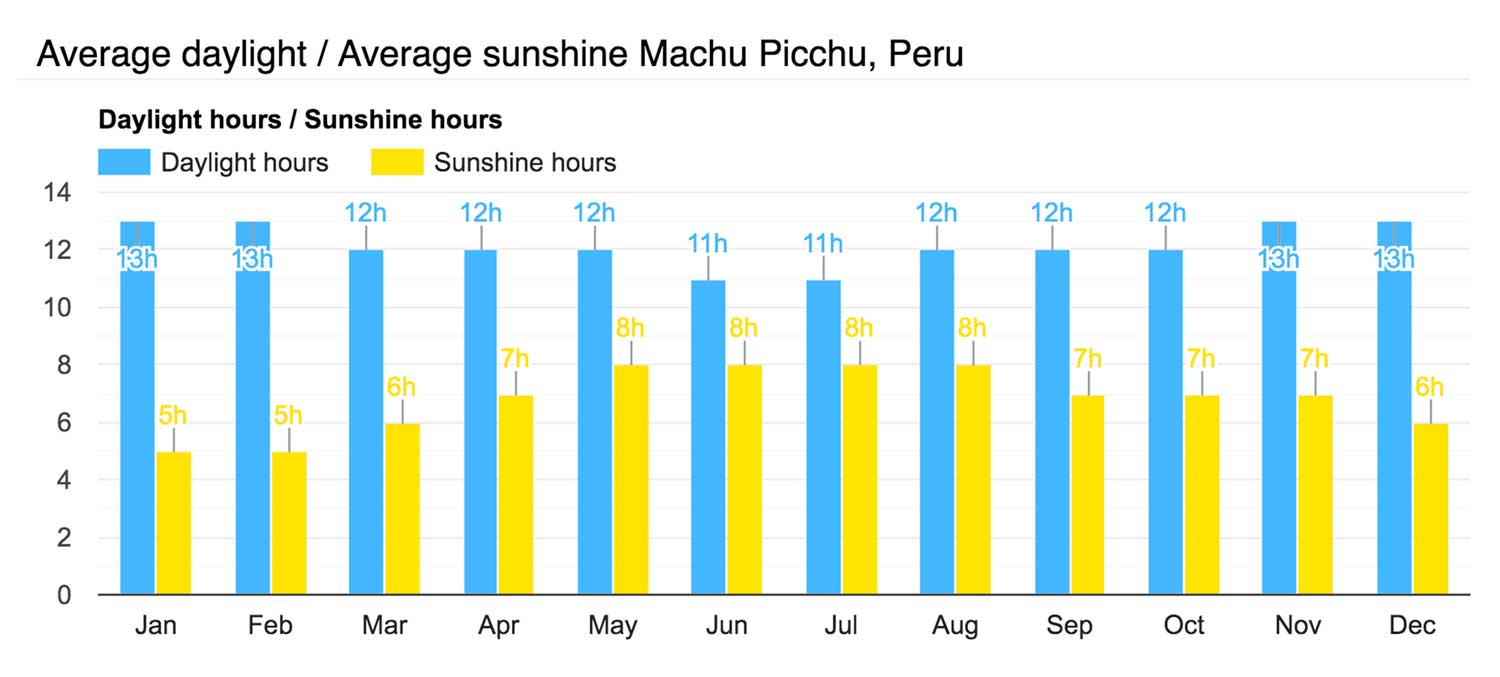
Daylight: The period of time between sunrise and sunset.
Average UV index
The months with the highest UV index are January, February, March, April, August, September, October, November and December (UV 12 index). The months with the lowest UV index are June and July (UV index 10).
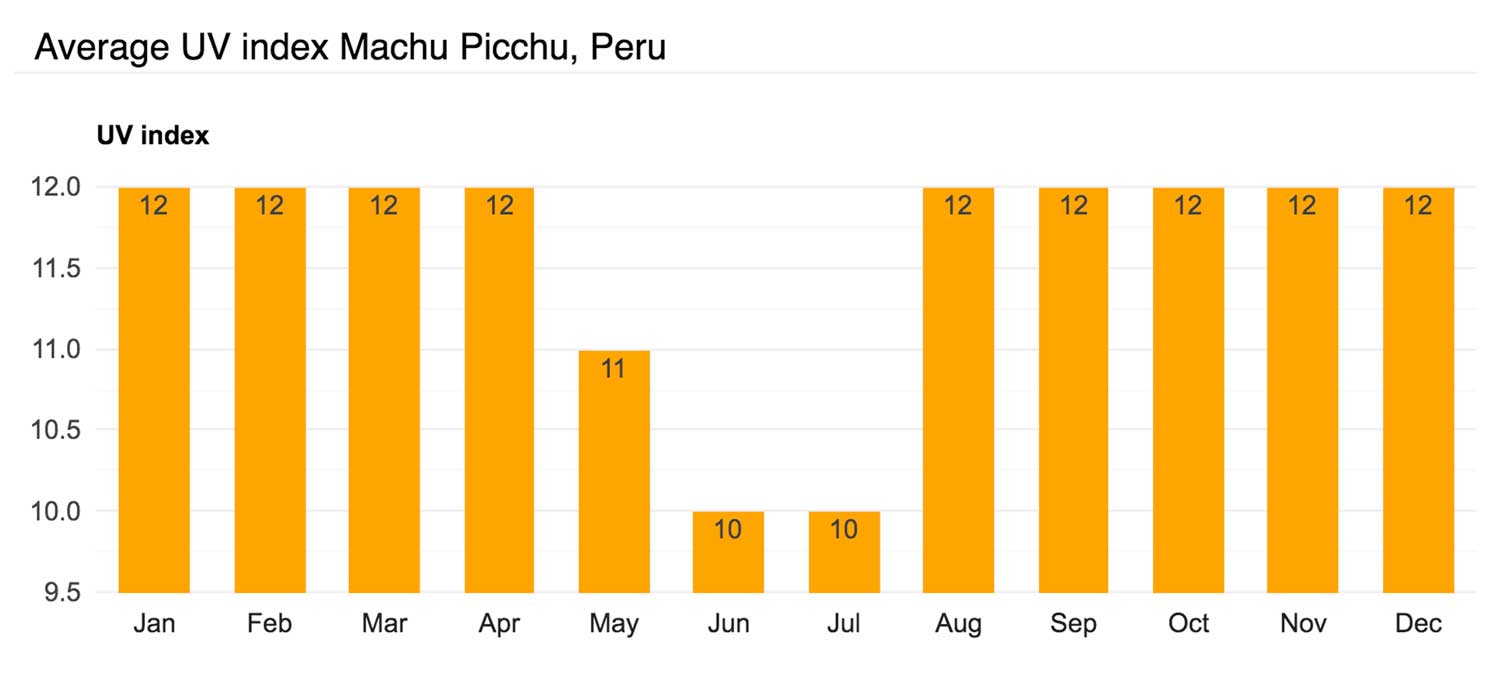
Recommendations
Here are some recommendations for the weather at Machu Picchu:
- Plan your visit during the dry season (May to September) if possible, as this is when the weather is generally the most pleasant.
- Bring rain gear if you visit during the rainy season (November to April), as there can be heavy rainfall at times.
- Dress in layers, as temperatures can vary greatly throughout the day.
- Wear sturdy, comfortable shoes for hiking and walking on uneven terrain.
- Use sunscreen and wear a hat to protect yourself from the strong sun at high altitudes.
- Stay hydrated by drinking plenty of water, especially if you are not accustomed to the high altitude.
- Be prepared for sudden changes in weather, as the weather can be unpredictable at times.
By following these recommendations, you can help ensure that your visit to Machu Picchu is as enjoyable and comfortable as possible, regardless of the weather conditions.
Faqs
It is rare for it to snow in Machu Picchu, located in high jungle, it is more likely to rain than snow.
Yes, it rains in Machu Picchu throughout the year, but the rainy season is from November to April.
The best weather for Machu Picchu is during the dry season (May to September), when there is less rain and more sunshine.
Machu Picchu’s climate varies depending on the month. In Fahrenheit, temperatures range from around 50°F (10°C) to 70°F (21°C) throughout the year.
The temperature at Machu Picchu varies throughout the year, but on average, temperatures range from around 50°F (10°C) to 70°F (21°C).
The weather in Machu Picchu can vary greatly depending on the season. During the dry season (May to September), it is generally sunny and dry, while during the rainy season (November to April), it can be cloudy and wet.
